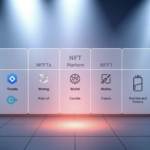Now Reading: Discover AI powered crypto lending and borrowing protocols
- 01
Discover AI powered crypto lending and borrowing protocols
Discover AI powered crypto lending and borrowing protocols

This Ultimate Guide helps readers in the United States learn how lending and borrowing work in decentralized finance using smart contracts. It covers core mechanics, risk metrics, interest models, liquidation, and governance so users can make better choices.
DeFi lets people lend and borrow without banks through publicly auditable contracts that enforce terms and manage collateral automatically. Leading platforms like Aave run around the clock, showing the scale of this software-defined finance market.
Liquidity pools and overcollateralization protect lenders while letting borrowers access assets quickly. Tools such as Aave’s Health Factor, Safety Module, audits, and bug bounties illustrate a security-first approach to risk.
This guide explains how interest and rates form, how governance works onchain, and how dynamic risk management—enhanced by machine learning—improves alerts and personalized strategies. You’ll also see practical steps for using platforms and for building a protocol with safety in mind.
Key Takeaways
- DeFi uses smart contracts to enable peer-to-peer lending with no banks.
- Top platforms like Aave show mature risk tools and governance models.
- Liquidity pools plus overcollateralization secure funds for lenders.
- Expect to learn about interest models, liquidation, and U.S. compliance.
- Machine learning boosts risk signals, dynamic rates, and user experience.
Why this Ultimate Guide matters right now for decentralized finance in the United States
Decentralized finance is entering a more mature phase. Audited code, institutional integrations, and formal governance make this a turning point for U.S. users.
Markets run 24/7, and programmable contracts can deliver faster access to credit and yield than traditional finance. That speed brings opportunity and new risks, so informed action matters.
Regulators in the United States are watching closely. Education on compliant, security-first usage is essential for individuals and institutions alike.
- Security and risk management drive institutional interest—Aave is often cited for audits, governance, and safety tools.
- Macro cycles affect rates and interest, so compare defi options to familiar offerings.
- Transparent onchain data lets users evaluate platforms directly instead of relying on opaque intermediaries.
Participation spans retail to enterprise. This guide will help you compare platforms, check fees, and interpret governance so you can navigate volatility and optimize returns responsibly.
From traditional lending to DeFi lending: how smart contracts reshape borrowers and lenders
Open, automated rules onchain remake the borrower–lender relationship by removing central approvals. This change puts transparent code at the center of market access and shifts duties from banks to users.
Unlike traditional banking: transparency, programmability, and 24/7 access
DeFi lending removes intermediaries so users interact directly with smart contracts. Rules for interest, collateral factors, and liquidations run the same for everyone.
Markets operate nonstop. That means offers, swaps, and settlements happen outside bank hours with lower fees and faster finality.
Credit scores vs collateral: how access changes when contracts replace gatekeepers
Traditional lending relies on credit checks and manual underwriting. DeFi shifts to collateral-based access, widening participation for people excluded by banks.
- Algorithmic systems automate approvals and interest accrual.
- Positions and reserves are visible onchain for real-time review.
- Composability lets borrowers link across platforms for swaps and yield strategies.
Caution: removing intermediaries increases user responsibility for keys, security, and reading contract rules. Audits, bug bounties, and governance form the active safety net in this new finance model.
Core mechanics of DeFi lending protocols: deposits, liquidity pools, and loans
Deposits aggregate into public vaults that let markets match supply with demand in real time. Smart contracts manage these pools, track balances, and enforce rules without human intermediaries.
Liquidity pools explained
When users supply assets, funds enter a shared pool. That pool makes loans available instantly to borrowers based on onchain rules.
Liquidity providers earn interest and sometimes extra token rewards for supplying crypto assets. Earnings vary with utilization and incentive programs.
Interest rate discovery
Rates form algorithmically. Higher borrowing demand vs. supply raises rates to attract more liquidity.
Different protocols offer distinct rate curves and reserve settings, so market rates change across platforms.
Overcollateralization and liquidation
Most systems require collateral above the loan value as the primary risk control. If collateral falls below thresholds, automated liquidations trigger.
Oracle prices, asset volatility, and pool depth shape collateral factors and liquidation mechanics. Transparent parameters—reserve factors, caps, and collateral ratios—help users assess risk.
- Deposits flow into pools managed by contracts for instant loan availability.
- Providers earn interest and potential token incentives for supplying assets.
- Utilization-driven rates adjust to balance supply and demand.
- Overcollateralization plus automated liquidation protect lenders during volatility.
- Composability lets deposited tokens serve other strategies, increasing utility and complexity.
Smart contracts in practice: automation, settlement, and risk controls
Onchain agreements translate loan terms into code that executes automatically at settlement. These systems encode repayment schedules, interest accrual, and collateral rules so actions occur without manual approval.
Programmable agreements
Code enforces rules deterministically, which cuts counterparty risk by removing discretionary human steps. When price feeds move or utilization rises, the logic triggers settlements and instant liquidations as written.

Open-source contracts let developers and users review protocol logic. Major platforms such as Aave publish audited code, use formal verification, and run bug bounties to uncover flaws before exploits occur.
- Third-party audits and formal proofs reduce common vulnerabilities.
- Bug bounties reward researchers who report issues early.
- Governance upgrades let token holders vote on parameter or code changes.
- Safety Modules, oracles, pause switches, and conservative collateral limits add extra protection.
Note: automation improves speed and transparency, but no system is risk-free. Users should weigh security posture against yields when choosing a platform.
Understanding interest: APR vs APY and what affects your returns
How returns are shown — with or without compounding — changes what a user actually earns over a year.
APR is the non‑compounded annualized figure. APY includes compounding and reflects true yearly yield. For a clear primer, see APY vs APR explained.
Compounding effects in DeFi: when APY diverges from APR
Frequent compounding in defi can make APY much higher than APR. Small, repeated gains add up over many compounding periods.
Tip: reinvestment frequency, token rewards, and fees change the gap between APY and APR.
Supply-demand and utilization rates: why platform rates move
Protocols set variable rates based on utilization. When borrowing demand rises or deposits fall, rates climb to attract liquidity.
- Define APR vs APY: APR excludes compounding; APY includes it.
- Utilization matters: More borrowing raises the interest rate curve, often sharply near a protocol’s kink point.
- Net returns: Reserve factors and platform fees reduce what suppliers keep after incentives.
- Market stress: Volatility can spike borrowing costs quickly, signaling tight liquidity or high demand.
Watch historical charts and average APY/APR to set realistic expectations. For a quick list of popular options, compare lending platforms.
Bottom line: consider compounding frequency, reward tokens, and whether you prefer stable or variable terms when projecting yields.
Risk metrics that matter: LTV, Health Factor, and utilization in lending platforms
Risk metrics turn price moves into clear signals for users. Knowing the right ratios helps you avoid forced sales and manage exposure when markets move fast.

Loan-to-Value and liquidation thresholds
Loan-to-Value (LTV) measures the loan amount relative to collateral value. Protocol-set liquidation thresholds tie directly to LTV.
Each platform sets collateral factors by asset based on liquidity, historical volatility, and market depth. A higher collateral factor lets you borrow more; a lower one limits risk.
Health Factor on platforms like Aave: staying above danger zones
The Health Factor is a composite safety score. Aave’s metric shows how close a position is to liquidation.
Staying above 1 is essential, but practical safety ranges are higher. Adding collateral raises the score; borrowing more or withdrawing collateral lowers it.
- Volatile assets and oracle price moves change LTV and Health Factor in real time.
- High pool utilization can push borrowing costs up and tighten liquidation buffers.
- Set personal buffers above protocol minimums to survive market swings and gas delays.
| Metric | What it shows | Action to improve | Platform note |
|---|---|---|---|
| LTV | Loan value vs. collateral | Reduce borrow or add collateral | Asset-specific factors apply |
| Health Factor | Composite safety score | Add collateral or repay debt | Aave exposes parameters publicly |
| Utilization | Pool usage rate | Monitor rates; avoid stressed pools | High utilization may raise interest |
| Oracle price | Feeds that set collateral value | Use diversified assets and watch feeds | Oracles can drive sudden LTV shifts |
Best practices: diversify collateral types, keep conservative LTVs, and enable alerts or script onchain monitors. Before taking leverage or looping strategies, study metrics and platform dashboards. For practical guides on loans, see cryptocurrency loans.
AI powered crypto lending and borrowing protocols
Forecasting volatility and liquidity lets teams tune collateral rules proactively. That approach improves onchain safety while keeping user access smoother in fast markets.
AI-driven risk management: volatility forecasting and collateral health
Risk management models use onchain events, price feeds, and cross‑platform signals to predict stress. Alerts can adjust Health Factor targets or suggest collateral top‑ups before liquidations occur.
Dynamic interest models: machine learning for rate optimization
Machine learning fine-tunes interest rates to match real‑time utilization. That reduces rate shocks and helps both lenders and borrowers enjoy steadier returns and costs.
Fraud detection and anomaly monitoring
Anomaly systems flag odd transactions, oracle deviations, and pool outliers for rapid review. Faster detection cuts exploit windows and protects overall liquidity.
User experience upgrades: personalized strategies and alerts
Personalized dashboards suggest rebalances, safe borrow limits, and yield paths based on behavior and risk tolerance. Models enhance liquidation bot efficiency to lower slippage while preserving pool solvency.
| Data sources | Role |
|---|---|
| Onchain events | Model inputs for behavior and flow |
| Price feeds | Volatility and LTV signals |
| Cross‑protocol signals | Liquidity and stress indicators |
Governance and privacy matter: models should be transparent, auditable, and governed by community controls. These tools augment audits and formal verification—not replace them—and must use guardrails to avoid feedback loops.
Spotlight on leading DeFi lending platforms: Aave, Compound, MakerDAO, and more
Examining Aave, Compound, and MakerDAO side‑by‑side shows tradeoffs in liquidity depth and safety models. This helps U.S. users pick a platform that fits their risk appetite and strategy.
Aave at scale
Aave runs on 12+ networks with tens of billions in deposits. It offers real‑time Health Factor monitoring and a Safety Module funded by staked AAVE to absorb rare shortfalls.
Audits, bug bounties, onchain governance, and the GHO stablecoin add layers of utility and oversight.
Compound and token incentives
Compound uses COMP incentives to reward suppliers and borrowers. Reserve factors capture a slice of borrower interest as protocol fees that grow the treasury.
MakerDAO and DAI stability
MakerDAO issues DAI from vaults backed by overcollateralized debt. Governance sets stability fees, liquidation ratios, and oracle sources.
- Compare supported assets, rate mechanics, and risk params before committing funds.
- Institutional adoption shows in wallet and exchange integrations that demand strong audits and governance.
- Test on a small scale or use testnets before larger deposits.
Real economics of a lending protocol: fees, spreads, and token incentives
Revenue lines—from interest spreads to flash fees—shape a platform’s incentives and solvency.
Net interest margin is the gap between borrower APRs and supplier APYs after reserve fees. Mature markets often show net margins near 2%.
Many systems retain roughly 10% of borrower interest as a reserve to fund operations and buffers. Liquidation penalties typically range 5–15%, compensating liquidators and protecting pools.
Other revenue streams
- Flash loan fees sit near 0.09% of volume; high aggregate use can produce tens of thousands of dollars in revenue.
- Treasury strategies stake idle reserves to earn ~5–10% APY while balancing security and liquidity needs.
- Institutional licensing and white‑label services may bring $25k–$100k per client; cross‑chain flows can add $10k–$50k depending on volume.
| Item | Typical range | Purpose |
|---|---|---|
| Net interest margin | ~2% | Protocol profitability after supplier returns |
| Reserve factor | ~10% of borrower interest | Risk buffer, treasury funding |
| Liquidation penalty | 5–15% | Incentivize liquidators, protect pools |
| Flash loan fee | ~0.09% | Arbitrage activity revenue |
| Treasury yield | 5–10% APY | Staking idle assets for returns |
Token appreciation ties to governance utility, revenue share, and ecosystem adoption. Transparent financial reporting helps users judge whether fee design aligns with solvency, user value, and long‑term sustainability in the defi market.
Security-first design: audits, bug bounties, and shortfall backstops
A layered security model reduces systemic risk and helps protect funds during stress. Open-source code invites community review so third parties and contributors can spot logic errors early. This transparency improves trust and speeds remediation.

How audited, open-source code reduces smart contract risk
Multiple independent audits and formal verification form a strong defense. Audits test for common flaws while formal proofs check core invariants in critical contracts.
Bug bounty programs add continuous coverage by rewarding external researchers. That broadens the security net between scheduled reviews.
- Safety Modules: insurance-funded pools can absorb rare shortfalls to protect users and funds.
- Governance control: upgrades require transparent votes, preventing unilateral changes to a platform.
- Operational security: key management, safe deployment practices, monitoring, and pause switches limit upgrade risk.
| Defence | Role |
|---|---|
| Audits & verification | Find and prove absence of critical bugs |
| Bug bounties | Ongoing community scanning |
| Safety reserve | Cover extreme losses |
Incident readiness—circuit breakers, live dashboards, and clear post-mortems—helps the market respond fast. Favor platforms with public audits and a record of security investment. In short, yields should never outpace prudent risk controls.
Governance in DeFi: tokens, proposals, and onchain execution
Community governance turns economic stakes into decision rights that guide protocol evolution. Holders of governance tokens gain the formal ability to propose changes, vote on parameter updates, and approve upgrades that affect platform safety and growth.
Participation and voting: AAVE, COMP, and community-driven upgrades
Governance tokens act as rights-bearing assets. They let users submit proposals, vote in defined periods, and trigger onchain execution when a proposal passes.
The lifecycle starts with forum discussion, then a formal proposal, followed by a voting window and, if approved, automated execution of the change. Security reviews and audits should precede any code deployment.
- AAVE: token holders steer Aave through AIPs; staking in the Safety Module creates a shortfall backstop while earning incentives.
- COMP: drives governance votes on fee policy, asset listings, and protocol parameters for Compound.
| Role | Example | Impact |
|---|---|---|
| Risk params | Collateral factors | Borrow capacity |
| Economic policy | Reserve fees | Platform treasury |
| Activation | New markets | Network growth |
Voter turnout can lag; delegates and service providers often help maintain active stewardship. Institutions cite credible governance when allocating capital, so transparent proposals, simulations, and clear risk analysis make decisions stronger.
Get involved: participate in discussions, review security notes, and vote to influence risk posture, interest settings, and long‑term strategy in the market.
Regulation and compliance considerations in the U.S. market
Institutional adoption depends on a platform’s ability to deliver compliant, auditable service layers. U.S. regulators expect clear controls, reporting, and entity-level responsibility before enterprises allocate capital.

Modular compliance frameworks
Modular frameworks let teams add KYC/AML, transaction screening, and reporting modules without rewriting core contracts. This preserves composability while meeting jurisdictional rules.
Institutional access models
Permissioned markets such as Aave Arc and treasury services like Compound Treasury show how platforms offer licensed access for firms. These models include on/off ramps, custodial options, and SLA‑style contracts.
- Onboarding tools: identity verification and risk checks for enterprise users.
- Governance: transparent processes for compliance upgrades and data access policies.
- Business case: licensing and white‑label services can bring $25,000–$100,000 per client in revenue.
| Feature | Purpose | Institutional need |
|---|---|---|
| KYC/AML | Prevent illicit flows | Regulatory acceptance |
| Permissioning | Limit market access | Counterparty risk control |
| Reporting | Audit trails | Compliance evidence |
Note: balancing user privacy with compliance is essential. Legal structuring, clear disclosures, and risk statements reassure investors while teams track cross‑border rules that affect global liquidity.
How to evaluate DeFi lending platforms as a user
Before you commit funds, compare platforms on liquidity depth, historical rates, and visible security work. Start small, test the UX, and verify onchain data so you know how a system behaves in stress.
Assess liquidity, rates, collateral factors, and audits
Check liquidity depth and utilization to gauge slippage, borrow availability, and whether rates will spike under load.
- Review historical rate charts, reserve factors, and spread behavior across market cycles.
- Read audit reports, formal verification notes, and active bug bounty pages to measure security commitment.
- Compare collateral factors, liquidation thresholds, and oracle sources for the assets you will supply or borrow.
- Try Health Factor tools and alerts to learn the platform’s risk UX before adding meaningful capital.
| Item | What to check | Why it matters |
|---|---|---|
| Liquidity | Pool depth & utilization | Slippage, borrow limits, rate stability |
| Security | Audits & bug bounties | Confidence in contracts and upgrades |
| Fees | Protocol fees & liquidation penalties | Net returns and downside costs |
Final tips: weigh governance maturity, multi‑chain reliability, and composability features. Use a hardware wallet, keep conservative LTVs, and scale positions as you gain trust.
Building a lending protocol: architecture, liquidity engineering, and operations
Designing a resilient lending system starts with clear contract boundaries and modular rate engines. The architecture must separate asset management, interest logic, and liquidation executors so each piece can be audited and upgraded independently.
Core components include asset manager contracts, rate modules, collateral configs, and keeper-friendly liquidation code. Teams tune dynamic rate curves to track utilization and market regimes while adding guardrails to avoid runaway feedback.
- Pool design: reserve factors, supplier incentives, and depth to reduce slippage.
- Liquidations: resilient oracles, keeper networks, and slippage‑aware execution.
- Compliance: modular KYC/ reporting lanes to serve institutional users without fragmenting liquidity.
Delivery follows an agile roadmap: discovery, MVP, audits, testnet pilots, mainnet launch, and post‑launch monitoring. Security is continuous—unit tests, fuzzing, property checks, formal verification, and multiple third‑party audits before and after launch.
| Area | Key focus | Outcome |
|---|---|---|
| Contracts | Modular, upgrade-safe code | Faster audits and easier upgrades |
| Rates | Dynamic curves with kinks & caps | Stable interest behavior under stress |
| Liquidity | Incentives & reserve sizing | Sustainable depth and lower slippage |
| Operations | Runbooks, governance cadence | Clear incident response and risk reviews |
Scale considerations include cross‑chain expansion, bridge risk controls, and treasury policies that favor long‑term solvency over short spikes in growth. Governance proposals should align token incentives with prudent risk limits and fund safety buffers.
Strategy playbook: lending, borrowing, leverage, and yield optimization
Start with simple steps: supply assets to earn yield, borrow only what you can safely cover, and repay to unlock collateral when needed.
Basic strategies include supplying stable or blue‑chip assets on a platform like Aave to collect interest and rewards. Borrow against that collateral to access cash without selling, then repay when you need to free the underlying asset.
Looping or leverage can amplify yield by repeatedly supplying and borrowing, but this raises liquidation risk sharply. Keep leverage modest and test how Health Factor responds to price moves.
Rate arbitrage means shifting positions between platforms or toggling stable vs variable borrowing when spreads favor savings. Use integrated swaps to rebalance, harvest rewards, or cut exposure without exiting the platform.
Collateral optimization matters: diversify collateral into less volatile assets to stabilize Health Factor. Set conservative LTVs, enable alerts, and top up collateral during volatility to avoid forced sales.
- Simulate price shocks and utilization spikes to see worst‑case outcomes.
- Use stablecoins such as GHO or DAI for predictable borrowing costs or yield anchors.
- Track U.S. tax rules: record interest received and note capital gains when rebalancing.
| Goal | Action | Risk control |
|---|---|---|
| Earn yield | Supply diversified assets | Use low‑volatility collateral |
| Access liquidity | Borrow against collateral | Keep conservative LTV |
| Amplify returns | Loop with caution | Limit leverage; test scenarios |
Final note: complexity brings operational risk. Start simple, document each step, and automate only after safe testing and clear runbooks.
Where AI and DeFi converge next: trends to watch and how to prepare
Where machine learning and DeFi converge next: trends to watch and how to prepare.
Expect governance tools to score proposals for risk and likely market impact before votes, with institutions such as Aave adopting adaptive risk management. Models will link cross‑chain signals to smooth rates and optimize routing, improving liquidity choices for users.
Oracles will add sanity checks to resist manipulation during shocks. Modular compliance and advanced anomaly detection will open wider institutional lanes while preserving onchain composability.
Actionable steps: pick security‑first platforms, learn rate mechanics, verify model disclosure and governance guardrails, and adopt enhanced monitoring tools thoughtfully.















